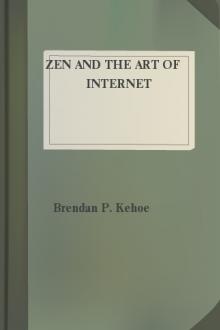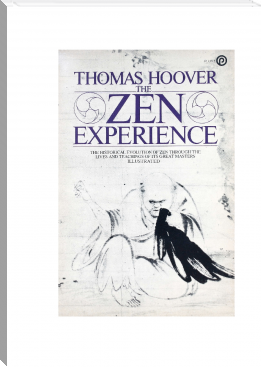Zen and the Art of Internet, Brendan P. Kehoe [top 100 novels TXT] 📗

- Author: Brendan P. Kehoe
- Performer: -
Book online «Zen and the Art of Internet, Brendan P. Kehoe [top 100 novels TXT] 📗». Author Brendan P. Kehoe
Syndicated Columns, including Dave Barry (humor) and Mike Royko (opinion).
Full information on ClariNet, including subscription information, is available from
Clarinet Communications Corp. 124 King St. North Waterloo, Ontario N2J 2X8 info@@clarinet.com (800) USE-NETS
or with anonymous FTP in the directory /Clarinet on ftp.uu.net (Anonymous FTP).
``Needless to say, Aristotle did not envisage modern finance.'' Frederick Copleston, S.J. A History of Philosophy: Vol 1 Greece & Rome Part II, p95
Things You'll Hear About
There are certain things that you'll hear about shortly after you start actively using the Internet. Most people assume that everyone's familiar with them, and they require no additional explanation. If only that were true!
This section addresses a few topics that are commonly encountered and asked about as a new user explores Cyberspace. Some of them are directly related to how the networks are run today; other points are simply interesting to read about.
The Internet Worm
from a letter by Severo M. Ornstein, in ACM June 89 Vol32 No6 and the appeal notice
On November 2, 1988, Robert Morris, Jr., a graduate student in Computer Science at Cornell, wrote an experimental, self-replicating, self-propagating program called a worm and injected it into the Internet. He chose to release it from MIT, to disguise the fact that the worm came from Cornell. Morris soon discovered that the program was replicating and reinfecting machines at a much faster rate than he had anticipated---there was a bug. Ultimately, many machines at locations around the country either crashed or became ``catatonic.'' When Morris realized what was happening, he contacted a friend at Harvard to discuss a solution. Eventually, they sent an anonymous message from Harvard over the network, instructing programmers how to kill the worm and prevent reinfection. However, because the network route was clogged, this message did not get through until it was too late. Computers were affected at many sites, including universities, military sites, and medical research facilities. The estimated cost of dealing with the worm at each installation ranged from $200 to more than $53,000. {Derived in part from a letter by Severo M. Ornstein, in the Communications of the ACM, Vol 32 No 6, June 1989.}
The program took advantage of a hole in the debug mode of the Unix sendmail program, which runs on a system and waits for other systems to connect to it and give it email, and a hole in the finger daemon fingerd, which serves finger requests (Finger). People at the University of California at Berkeley and MIT had copies of the program and were actively disassembling it (returning the program back into its source form) to try to figure out how it worked.
Teams of programmers worked non-stop to come up with at least a temporary fix, to prevent the continued spread of the worm. After about twelve hours, the team at Berkeley came up with steps that would help retard the spread of the virus. Another method was also discovered at Purdue and widely published. The information didn't get out as quickly as it could have, however, since so many sites had completely disconnected themselves from the network.
After a few days, things slowly began to return to normalcy and everyone wanted to know who had done it all. Morris was later named in The New York Times as the author (though this hadn't yet been officially proven, there was a substantial body of evidence pointing to Morris).
Robert T. Morris was convicted of violating the computer Fraud and Abuse Act (Title 18), and sentenced to three years of probation, 400 hours of community service, a fine of $10,050, and the costs of his supervision. His appeal, filed in December, 1990, was rejected the following March.
The Cuckoo's Egg
First in an article entitled ``Stalking the Wily Hacker,'' and later in the book The Cuckoo's Egg, Clifford Stoll detailed his experiences trying to track down someone breaking into a system at Lawrence Berkeley Laboratory in California. {See the bibliography for full citations.}
A 75-cent discrepancy in the Lab's accounting records led Stoll on a chase through California, Virginia, and Europe to end up in a small apartment in Hannover, West Germany. Stoll dealt with many levels of bureaucracy and red tape, and worked with the FBI, the CIA, and the German Bundespost trying to track his hacker down.
The experiences of Stoll, and particularly his message in speaking engagements, have all pointed out the dire need for communication between parties on a network of networks. The only way everyone can peacefully co-exist in Cyberspace is by ensuring rapid recognition of any existing problems.
Organizations
The indomitable need for humans to congregate and share their common interests is also present in the computing world. User groups exist around the world, where people share ideas and experiences. Similarly, there are organizations which are one step ``above'' user groups; that is to say, they exist to encourage or promote an idea or set of ideas, rather than support a specific computer or application of computers.
The Association for Computing Machinery
The Association for Computing Machinery (the ACM) was founded in 1947, immediately after Eckert and Mauchly unveiled one of the first electronic computers, the ENIAC, in 1946. Since then, the ACM has grown by leaps and bounds, becoming one of the leading educational and scientific societies in the computer industry.
The ACM's stated purposes are:
To advance the sciences and arts of information processing;
To promote the free interchange of information about the sciences and arts of information processing both among specialists and among the public;
To develop and maintain the integrity and competence of individuals engaged in the practices of the sciences and arts of information processing.
Membership in the ACM has grown from seventy-eight in September, 1947, to over 77,000 today. There are local chapters around the world, and many colleges and universities endorse student chapters. Lecturers frequent these meetings, which tend to be one step above the normal ``user group'' gathering. A large variety of published material is also available at discounted prices for members of the association.
The ACM has a number of Special Interest Groups (SIGs) that concentrate on a certain area of computing, ranging from graphics to the Ada programming language to security. Each of the SIGs also publishes its own newsletter. There is a Usenet group, comp.org.acm, for the discussion of ACM topics. Usenet News for more information on reading news.
For more information and a membership application, write to:
Assocation for Computing Machinery 1515 Broadway New York City, NY 10036 ACMHELP@ACMVM.BITNET
(212) 869-7440
Computer Professionals for Social Responsibility from their letter to prospective members
The CPSR is an alliance of computer professionals concentrating on certain areas of the impact of computer technology on society. It traces its history to the fall of 1981, when several researchers in Palo Alto, California, organized a lunch meeting to discuss their shared concerns about the connection between computing and the nuclear arms race. Out of that meeting and the discussions which followed, CPSR was born, and has been active ever since. {This section is part of the CPSR's letter to prospective members.}
The national CPSR program focuses on the following project areas:
Reliability and Risk This area reflects on the concern that overreliance on computing technology can lead to unacceptable risks to society. It includes, but isn't limited to, work in analyzing military systems such as SDI.
Civil Liberties and Privacy This project is concerned with such topics as the FBI National Crime Information Center, the growing use of databases by both government and private industry, the right of access to public information, extension of First Amendment rights to electronic communication, and establishing legal protections for privacy of computerized information.
Computers in the Workplace The CPSR Workplace Project has concentrated its attention on the design of software for the workplace, and particularly on the philosophy of ``participatory design,'' in which software designers work together with users to ensure that systems meet the actual needs of that workplace.
The 21st Century Project This is a coalition with other professional organizations working towards redirecting national research priorities from concentrating on military issues to anticipating and dealing with future problems as science and technology enter the next century.
For more information on the CPSR, contact them at:
Computer Professionals for Social Responsibility P.O. Box 717 Palo Alto, CA 94302 cpsr@csli.stanford.edu
(415) 322--3778
(415) 322--3798 (Fax)
The Electronic Frontier Foundation
The Electronic Frontier Foundation (EFF) was established to help civilize the ``electronic frontier''---the Cyberspacial medium becoming ever-present in today's society; to make it truly useful and beneficial not just to a technical elite, but to everyone; and to do this in a way which is in keeping with the society's highest traditions of the free and open flow of information and communication. {This section was derived from eff.about, available along with other material via anonymous FTP from ftp.eff.org}
The mission of the EFF is to engage in and support educational activities which increase popular understanding of the opportunities and challenges posed by developments in computing and telecommunications;
to develop among policy-makers a better understanding of the issues underlying free and open telecommunications, and support the creation of legal and structural approaches which will ease the assimilation of these new technologies by society;
to raise public awareness about civil liberties issues arising from the rapid advancement in the area of new computer-based communications media and, where necessary, support litigation in the public interest to preserve, protect, and extend First Amendment rights within the realm of computing and telecommunications technology;
to encourage and support the development of new tools which will endow non-technical users with full and easy access to computer-based telecommunications;
The Usenet newsgroups comp.org.eff.talk and comp.org.eff.news are dedicated to discussion concerning the EFF. They also have mailing list counterparts for those that don't have access to Usenet, eff-talk-request@eff.org and eff-news-request@eff.org. The first is an informal arena (aka a normal newsgroup) where anyone may voice his or her opinions. The second, comp.org.eff.news, is a moderated area for regular postings from the EFF in the form of EFFector Online. To submit a posting for the EFFector Online, or to get general information about the EFF, write to eff@eff.org. There is also a wealth of information available via anonymous FTP on ftp.eff.org.
The EFF can be contacted at
The Electronic Frontier Foundation, Inc. 155 Second St. #1 Cambridge, MA 02141 eff@eff.org
(617) 864-0665
(617) 864-0866 (Fax)
The Free Software Foundation
The Free Software Foundation was started by Richard Stallman (creator of the popular GNU Emacs editor). It is dedicated to eliminating restrictions on copying, redistributing, and modifying software.
The word ``free'' in their name does not refer to price; it refers to freedom. First, the freedom to copy a program and redistribute it to your neighbors, so that they can use it as well as you. Second, the freedom to change a program, so that you can control it instead of it controlling you; for this, the source code must be made available to you.
The Foundation works to provide these freedoms by developing free compatible replacements for proprietary software. Specifically, they are putting together a complete, integrated software system called GNU'' that is upward-compatible with Unix. {As an aside, the editor of the GNU project, emacs, contains a built-in LISP interpreter and a large part of its functionality is written in LISP. The name GNU is itself recursive (the mainstay of the LISP language); it stands forGnu's Not Unix.''}
When it is released, everyone will be permitted to copy it and distribute it to others. In addition, it will be distributed with source code, so you will be able to learn about operating systems by reading it, to port it to your own machine,





Comments (0)